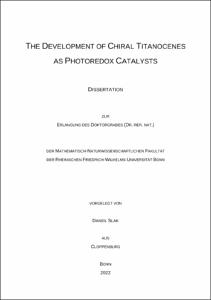Slak, Daniel: The Development of Chiral Titanocenes as Photoredox Catalysts. - Bonn, 2023. - Dissertation, Rheinische Friedrich-Wilhelms-Universität Bonn.
Online-Ausgabe in bonndoc: https://nbn-resolving.org/urn:nbn:de:hbz:5-69379
Online-Ausgabe in bonndoc: https://nbn-resolving.org/urn:nbn:de:hbz:5-69379
@phdthesis{handle:20.500.11811/10599,
urn: https://nbn-resolving.org/urn:nbn:de:hbz:5-69379,
author = {{Daniel Slak}},
title = {The Development of Chiral Titanocenes as Photoredox Catalysts},
school = {Rheinische Friedrich-Wilhelms-Universität Bonn},
year = 2023,
month = jan,
note = {This dissertation describes the advances in photochemically activated (chiral) titanocenes as both electron transfer and photoredox catalysts in epoxide opening reactions. Based on the discovery of the photoredox-active properties of titanocene dichloride and the resulting successful employment as photoredox catalyst, the applicability of these properties in other types of titanocene catalyzed reactions was investigated. The performance of various other titanocenes with different photochemical and electronic properties was also examined. Moreover, newly developed reaction conditions enabled the renunciation of previously required unsustainable and toxic reagents by replacing them with catalytic alternatives.
For radical arylations, as well as regio- and diastereodivergent epoxide openings, the chiral and enantiomerically pure titanocene known as Kagan’s complex has been successfully used either in combination with an external, organic photoredox catalyst or as photoredox catalyst itself in the synthesis of various new compounds.
Gratifyingly, novel reaction conditions tolerating the presence of commonly used and previously obstructive silyl-protecting groups have been found, giving access to selectively monoprotected, enantio- and diastereomerically pure 1,3- and 1,4-diol-structures. Moreover, the yields of the originally used conditions for already established REO reaction products could be matched.
By this photochemical approach, not only an improvement regarding sustainability has been achieved, but also the substrate scope has been extended. This renders the method a potentially useful and reliable tool for the synthesis of naturally occurring and often biologically active diol-moieties in natural product or pharmaceutical drug synthesis.},
url = {https://hdl.handle.net/20.500.11811/10599}
}
urn: https://nbn-resolving.org/urn:nbn:de:hbz:5-69379,
author = {{Daniel Slak}},
title = {The Development of Chiral Titanocenes as Photoredox Catalysts},
school = {Rheinische Friedrich-Wilhelms-Universität Bonn},
year = 2023,
month = jan,
note = {This dissertation describes the advances in photochemically activated (chiral) titanocenes as both electron transfer and photoredox catalysts in epoxide opening reactions. Based on the discovery of the photoredox-active properties of titanocene dichloride and the resulting successful employment as photoredox catalyst, the applicability of these properties in other types of titanocene catalyzed reactions was investigated. The performance of various other titanocenes with different photochemical and electronic properties was also examined. Moreover, newly developed reaction conditions enabled the renunciation of previously required unsustainable and toxic reagents by replacing them with catalytic alternatives.
For radical arylations, as well as regio- and diastereodivergent epoxide openings, the chiral and enantiomerically pure titanocene known as Kagan’s complex has been successfully used either in combination with an external, organic photoredox catalyst or as photoredox catalyst itself in the synthesis of various new compounds.
Gratifyingly, novel reaction conditions tolerating the presence of commonly used and previously obstructive silyl-protecting groups have been found, giving access to selectively monoprotected, enantio- and diastereomerically pure 1,3- and 1,4-diol-structures. Moreover, the yields of the originally used conditions for already established REO reaction products could be matched.
By this photochemical approach, not only an improvement regarding sustainability has been achieved, but also the substrate scope has been extended. This renders the method a potentially useful and reliable tool for the synthesis of naturally occurring and often biologically active diol-moieties in natural product or pharmaceutical drug synthesis.},
url = {https://hdl.handle.net/20.500.11811/10599}
}






